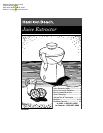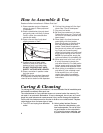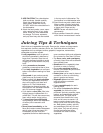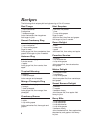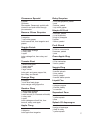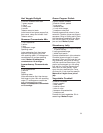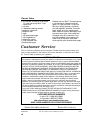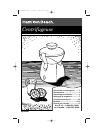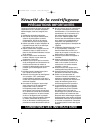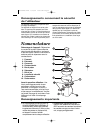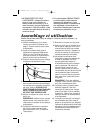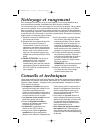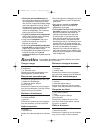
5
• Leafy vegetables, such as spinach,
should be processed in batches no
larger than 2 pounds. Stop the unit
and clean between batches to avoid
clogging the cutter/strainer and pulp
bowl.
• Juicing avocados or bananas
produces a puree rather than a juice.
• Form leafy vegetables into compact
balls or rolls before inserting into food
chute.
• One pound of raw produce usually
yields one cup (8 ounces) of juice.
• When working with large quantities
of fruits and vegetables, be sure to
stop unit to empty pulp bowl as it
begins to fill. The cutter/strainer
should also be cleaned regularly, as
the extraction will decrease consider-
ably if it becomes clogged.
• If you desire a clear juice, filter juice
through layers of cheesecloth or a
coffee filter. This will also remove any
foam which results during juicing.
• To keep juices from discoloring
during storage, add a few teaspoons
of lemon juice or ascorbic acid
powder.
• Serve juices immediately, as the
flavor and nutrient content decreases
rapidly when juices are stored. If it
is necessary to juice fruits and
vegetables some time before serving,
cover container tightly and refrigerate.
Do not store for more than 24 hours.
• The flavor, color, and consistency
of freshly juiced fruits will be different
from canned juices.
• Substitute fruit or vegetable juices
for stock or water in cooking.
• Some pulp remaining in juice is
normal. It increases the juice’s flavor
and nutritional value.
• Potato juice can be used in place of
cornstarch or flour as a thickening
agent in gravies and soups.
• Vegetable juice mixed with carrot
juice will produce a sweeter
vegetable flavor.
• Freeze vegetable pulp for use in
making soups.
• The softer the texture of a fruit or
vegetable, the thicker the juice
produced. Apricots, peaches, pears,
melons, and strawberries are soft-
textured fruits. The juice that is
extracted from these fruits is very
thick and is known as nectar. It is
best to combine these juices with
thinner juices, such as carrot, apple,
etc. Beet greens, parsley, spinach,
and watercress yield very rich and
thick juices. They are very strong-
flavored and taste best when
combined with other fruits and
vegetables.
Juicing Tips & Techniques
Wash fruits and vegetables thoroughly. Remove pits, stones, and large seeds
from apricots, cherries, peaches, plums, etc. Peel thick-skinned fruits and
vegetables such as oranges, lemons, grapefruit, tangerines, watermelons,
pineapples and winter squash.
3. USE CAUTION: The cutter/strainer
teeth are sharp. Handle carefully.
Wash the cutter/strainer in hot,
soapy water. Rinse then let dry.
DO NOT WASH the cutter/strainer in
the dishwasher.
4. Wash the food pusher, cover, sepa-
rator, and pulp bowl, in hot, soapy
water. Rinse, dry, and reassemble
for storage. The cover, separator,
and pulp bowl may also be washed
in the top rack of dishwasher. The
food pusher is not dishwasher safe.
5. Some foods may stain plastic parts.
Make a paste of baking soda and
water and rub on stained area with
a damp cloth. Rinse and dry.
NOTE: Carrots will stain the unit
permanently.
6. Wipe outside of base with a damp
cloth. Never immerse base in water.



